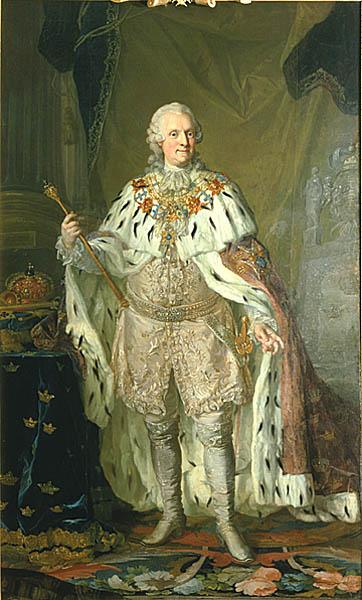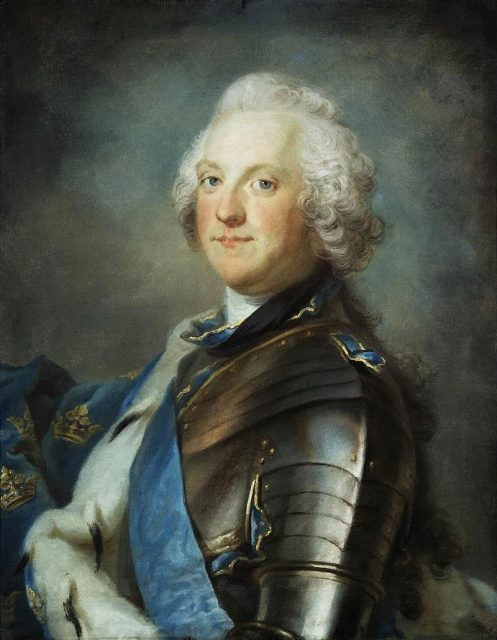
Ideally, monarchs go down in history remembered for their great accomplishments, but that was not the case with Adolf Frederick of Sweden. This 18th-century king is instead remembered for his over-vigorous preparation for Lent. His fondness for a traditional Swedish sweet bun called semla (plural selmor) ultimately led to his death, on February 12, 1771.
While royal banquets are perhaps noted for elaborate overeating, this one, in particular, turned out to be Adolf’s last big, fat, carbs-rich meal: lobster and caviar, some fish and sauerkraut among other things, and plenty of champagne. Add to that 14 dishes of semla–just the right dosage to cause His Majesty to suffer from overeating, complications in his digestive tract, and ultimately passing away. No king would have ever chosen to die such an embarrassing death.

Adolph Frederick of Sweden c 1751 by Gustaf Lundberg & Jakob Björck
By the time he died, King Adolf Frederick had ruled his Nordic kingdom for two decades, during Sweden’s Age of Liberty, a period when there were no wars and civil rights improved, but also a time when the economy stagnated. Although other good things were happening under Adolf’s reign–the parliament of the country passed progressive legislation that concerned freedoms in media–many contemporaries still did not see the most competent person in this king.

Adolf Frederick, King of Sweden
Moreover, Adolf’s ascension to the throne came in an unorthodox way, too. It was made possible by the influence of his aunt, Empress Elizabeth of Russia, after her victory in the Russo-Swedish War (1741-1743). The Russian queen negotiated to return much of Finland to Swedish rule, as well as other peace treaty concessions if Adolf Frederick was declared successor to the throne following the death of King Frederick I of Sweden, which happened in 1751.
Even after taking up the Crown, it seemed that the parliament enjoyed more powers and authority than the king himself. He was more of a constitutional figurehead. But no affair of his court is as outrageous as the way in which he left this world.

A semla is a traditional pastry in Sweden and Finland, associated with Lent and especially Shrove Tuesday.
King Adolf Frederick’s last supper and why he ate himself to death relates to the traditional celebratory feast, known as fettisdag (or Fat Tuesday) in Swedish, before the Christian fasting period of Lent. Whether you call it Mardi Gras, Shrove Tuesday, or Pancake Day, it’s a celebration of indulgence in rich or fatty foods–a way to use up everything that is not allowed to be eaten during Lent.

Adolf Frederick in old age as King, by Lorens Pasch the Younger
The king’s main course on his last fettisdag in 1771 was abundant and nutritious enough. It was the dessert that is assumed to have finished him off. After the first dish of hetvägg, a selma pastry bun soaked in warm milk or cream, the king opted for 13 more courses.

Adolf Fredrik memorial. Photo by: Jan Ainali CC BY-SA 3.0
The Selmor that can be found in bakeries across Sweden today are a slightly more elaborate affair, filled with whipped cream and almond paste, and have become part of the fabric of Swedish culture. Historically, semlor were eaten only on fettisdag (not the case any longer) and it might have been what the king secretly craved all year round. Or maybe it was due to the stress of his duties that he devoured the treat so ferociously. However, soon after Adolf was finished with his vice, he has also finished with his life. The abundant meal that could have fed a person for the entire week now caused him digestive problems. He died that same day.

Portrait of Adolf Frederick, King of Sweden
It was the end of the king; it was the end also of Sweden’s tough won Age of Liberty. Adolf’s son, Gustav III, succeeded him and everything changed. Some people loved the new king as he improved the culture and arts in the country, but he is also remembered for deceiving the public, initiating a sort of dictatorship in which he largely censored media freedoms. A war was started, one that Sweden later lost to Russia. Gustav III’s life ended when he was assassinated in 1792.
Despite his bizarre death, Adolf was still a loved king, at least by his nearest and dearest. When he died, everyone who had experienced his friendship, his family, friends, and servants, deeply grieved for him. He was, after all, also remembered as a kind king.
